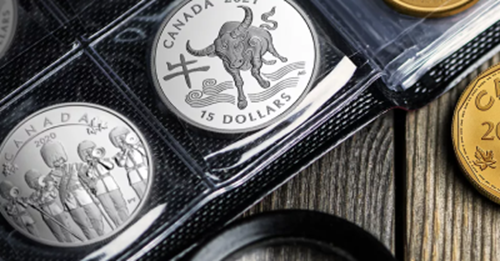
ARCHIVED
100th Anniversary of In Flanders Fields: 1 oz. Fine Silver Coin – Mintage: 10,000 (2015)
2015
Mintage 10,000
ARCHIVED
100th Anniversary of In Flanders Fields: 1 oz. Fine Silver Coin – Mintage: 10,000 (2015)
2015
Mintage 10,000
$89.95 CAD
Masters Club:
900
Status: CAN & US shipping only
Availability:
Out of stock in stores
About
Commemorates John McCrae’s famous poem. A touching tribute.
In Flanders fields the poppies blow
Between the crosses, row on row,
That mark our place; and in the sky
The larks, still bravely singing, fly
Scarce heard amid the guns below.
- In Flanders Fields, John McCrae (1872-1918)
It has become part of our collective memory of the First World War,a hauntingly beautiful poem that gives one voice tothe thousands of fallen soldiers. Inspired by the tragic death of a friend during the Second Battle of Ypres in May 1915, In Flanders Fields by Canadian physician Lieutenant Colonel JohnMcCrae emerged as the most popular poem of the First World War—one that is still recited around the world each year—and inspired an international effort to remember those who made the ultimate sacrifice. To mark the poem’s centennial anniversary, this fine silver coin is a solemn remembrance of those who bravely served their country abroad in a time of war—lest we forget.
Commemorates John McCrae’s famous poem. Order today!
Special features:
• FEATURES THE EFFIGY OF KING GEORGE V: The obverse features the effigy of King George V by
Sir E. B. MacKennal.
• A poignant commemoration of Canadian John McCrae’s famous poem that is often recited during annual remembrance ceremonies in many countries.
• The poem served as theinspiration behind the adoption of the poppy as a widely recognized memorial symbol, making this coin afitting tribute to the brave Canadians who served their country in times of war—not only in the First World War, but in other conflicts that followed.
• Crafted from 99.99% pure silver, with a limited mintage 10,000 worldwide.
• Finely detailed engraving is beautifully enhanced through the use of multiple finishes that bring added depth and dimension to the stirring design.
• A striking collectible forcommemorators, and a prestigious addition to any Canadian military- or history-themed collection.
• A symbolic gift for those in the military, or as a tribute to loved ones who werelost at war.
• Your coin is GST/HST exempt.
About the Design:
Designed by Canadian artist Laurie McGaw, your coin transports you back to 1915 with an intricately engraved image that evokes the opening lines of John McCrae’s poem, In Flanders Fields. With his helmet removed and head bent in mourning, a lone Canadian soldier stands before amakeshift gravesite for fellow soldiers who were killed in battle; their final resting place resembles the Belgian fields near the Ypres salient, which provided the natural setting for McCrae’s haunting poem and contributed to the theme of the continuing cycle of life amid the devastation of war. To the left of the soldier, a large image of a poppy offers a close view of the flowers that have become synonymous with remembrance; these same wild blooms are also seen to the right of the soldier, emerging from the upturned earth to grow “between thecrosses, row on row, that mark our place.” In the glow of the sunset, two birds in flight echo McCrae’s words: “and in the sky, The larks, still bravely singing, fly…”
Did you know…
• Originally, the first line read “In Flanders fields the poppies grow” but the editor of Punch magazine requested McCrae’s permission to change it to “the poppies blow” in order to differentiate it from the very last lineof the poem.
• The poem’s popularity and its reference to the bloomsgrowing over the soldiers’ graves helped inspire a widespread movement to adopt the poppy as a memorial symbol–a practice still observed in Canada, France, the United States, Britain and other Commonwealth nations.
• Often quoted, In Flanders Fields was used to help sellCanadian war bonds, providing a boost in a campaignthat raised $400 million—far more than the target of $150 million.
• More than 600,000 men andwomen from across Canada served as soldiers, nursesand chaplains during the First World War from 1914 to 1918; of those, 60,000 perished during the conflict.
Born in Guelph, Ont., John McCrae (1872-1918) was a compassionate doctor, a respected professor, and a veteran of the South African War. Enlisting soon after First World War was declared, McCrae was assigned second-in-command ofthe 1st Brigade of the Canadian Field Artillery, where his medical training made him invaluable as the brigade surgeon.
While the First Canadian Division valiantly fought in the Ypres salient, a friend’s death inspired McCrae to write his famous poem. On the morning of May 2, 1915, 22-year-old Lieutenant Alexis Helmer of Ottawa, Ont., was killed by enemy artillery fire upon emerging from his dugout. In the absence of a chaplain, McCrae himself presided over the funeral service as Helmer’s remains were deposited in a makeshift grave marked by a simple wooden cross. While accounts vary, it is generally believed that McCrae wrote his famous poem the next day on the back step of an ambulance, in sight of Helmer’s grave and near the fields that were filling with the casualties of war.
McCrae set aside the poem–the second last he would write–only to take it up again after leaving Ypres for Boulogne. A finished copy was submittedto The Spectator in London but was rejected for publication; thankfully, a journalist brought back a copy to England’s Punch magazine, which printed it anonymously on December 8, 1915. With its theme of remembrance and the powerful visual of bright red poppies growing amid the devastation of war, thepoem became widely seen as the embodiment of how soldiers viewed this war; the author of this popular poem soon became known.
A hundred years later, McCrae’s own legacy andhis poem live on. While McCrae would succumb to illness and exhaustion in January 1918, his written words continue to give a voice to the fallen—one that time would not forget. After the war, it inspired the movement to recognize the poppy as the official symbol of remembrance after the war—a tradition that has continued, in the weeks leading up to Remembrance Day (Nov. 11) each year, when Canadians don this bright red symbol to honour the legacy of the more than 600,000 Canadians who served in the First World War, and the 60,000 of them who lost their lives.
Packaging:
Your coin is encapsulated and presented in a Royal Canadian Mint-branded maroon clamshell with a graphic beauty box.
Order your coin today!
Between the crosses, row on row,
That mark our place; and in the sky
The larks, still bravely singing, fly
Scarce heard amid the guns below.
- In Flanders Fields, John McCrae (1872-1918)
It has become part of our collective memory of the First World War,a hauntingly beautiful poem that gives one voice tothe thousands of fallen soldiers. Inspired by the tragic death of a friend during the Second Battle of Ypres in May 1915, In Flanders Fields by Canadian physician Lieutenant Colonel JohnMcCrae emerged as the most popular poem of the First World War—one that is still recited around the world each year—and inspired an international effort to remember those who made the ultimate sacrifice. To mark the poem’s centennial anniversary, this fine silver coin is a solemn remembrance of those who bravely served their country abroad in a time of war—lest we forget.
Commemorates John McCrae’s famous poem. Order today!
Special features:
• FEATURES THE EFFIGY OF KING GEORGE V: The obverse features the effigy of King George V by
Sir E. B. MacKennal.
• A poignant commemoration of Canadian John McCrae’s famous poem that is often recited during annual remembrance ceremonies in many countries.
• The poem served as theinspiration behind the adoption of the poppy as a widely recognized memorial symbol, making this coin afitting tribute to the brave Canadians who served their country in times of war—not only in the First World War, but in other conflicts that followed.
• Crafted from 99.99% pure silver, with a limited mintage 10,000 worldwide.
• Finely detailed engraving is beautifully enhanced through the use of multiple finishes that bring added depth and dimension to the stirring design.
• A striking collectible forcommemorators, and a prestigious addition to any Canadian military- or history-themed collection.
• A symbolic gift for those in the military, or as a tribute to loved ones who werelost at war.
• Your coin is GST/HST exempt.
About the Design:
Designed by Canadian artist Laurie McGaw, your coin transports you back to 1915 with an intricately engraved image that evokes the opening lines of John McCrae’s poem, In Flanders Fields. With his helmet removed and head bent in mourning, a lone Canadian soldier stands before amakeshift gravesite for fellow soldiers who were killed in battle; their final resting place resembles the Belgian fields near the Ypres salient, which provided the natural setting for McCrae’s haunting poem and contributed to the theme of the continuing cycle of life amid the devastation of war. To the left of the soldier, a large image of a poppy offers a close view of the flowers that have become synonymous with remembrance; these same wild blooms are also seen to the right of the soldier, emerging from the upturned earth to grow “between thecrosses, row on row, that mark our place.” In the glow of the sunset, two birds in flight echo McCrae’s words: “and in the sky, The larks, still bravely singing, fly…”
Did you know…
• Originally, the first line read “In Flanders fields the poppies grow” but the editor of Punch magazine requested McCrae’s permission to change it to “the poppies blow” in order to differentiate it from the very last lineof the poem.
• The poem’s popularity and its reference to the bloomsgrowing over the soldiers’ graves helped inspire a widespread movement to adopt the poppy as a memorial symbol–a practice still observed in Canada, France, the United States, Britain and other Commonwealth nations.
• Often quoted, In Flanders Fields was used to help sellCanadian war bonds, providing a boost in a campaignthat raised $400 million—far more than the target of $150 million.
• More than 600,000 men andwomen from across Canada served as soldiers, nursesand chaplains during the First World War from 1914 to 1918; of those, 60,000 perished during the conflict.
Born in Guelph, Ont., John McCrae (1872-1918) was a compassionate doctor, a respected professor, and a veteran of the South African War. Enlisting soon after First World War was declared, McCrae was assigned second-in-command ofthe 1st Brigade of the Canadian Field Artillery, where his medical training made him invaluable as the brigade surgeon.
While the First Canadian Division valiantly fought in the Ypres salient, a friend’s death inspired McCrae to write his famous poem. On the morning of May 2, 1915, 22-year-old Lieutenant Alexis Helmer of Ottawa, Ont., was killed by enemy artillery fire upon emerging from his dugout. In the absence of a chaplain, McCrae himself presided over the funeral service as Helmer’s remains were deposited in a makeshift grave marked by a simple wooden cross. While accounts vary, it is generally believed that McCrae wrote his famous poem the next day on the back step of an ambulance, in sight of Helmer’s grave and near the fields that were filling with the casualties of war.
McCrae set aside the poem–the second last he would write–only to take it up again after leaving Ypres for Boulogne. A finished copy was submittedto The Spectator in London but was rejected for publication; thankfully, a journalist brought back a copy to England’s Punch magazine, which printed it anonymously on December 8, 1915. With its theme of remembrance and the powerful visual of bright red poppies growing amid the devastation of war, thepoem became widely seen as the embodiment of how soldiers viewed this war; the author of this popular poem soon became known.
A hundred years later, McCrae’s own legacy andhis poem live on. While McCrae would succumb to illness and exhaustion in January 1918, his written words continue to give a voice to the fallen—one that time would not forget. After the war, it inspired the movement to recognize the poppy as the official symbol of remembrance after the war—a tradition that has continued, in the weeks leading up to Remembrance Day (Nov. 11) each year, when Canadians don this bright red symbol to honour the legacy of the more than 600,000 Canadians who served in the First World War, and the 60,000 of them who lost their lives.
Packaging:
Your coin is encapsulated and presented in a Royal Canadian Mint-branded maroon clamshell with a graphic beauty box.
Order your coin today!
Specifications
Product Number
144527
Mintage
10,000
Composition
99.99% pure silver
Weight
31.39 g
Edge
serrated
Certificate
serialized
Face Value
20 dollars
Finish
proof
Artist
Laurie McGaw (reverse), Sir E.B. MacKennal (obverse)
Reviews
Questions
What do you want to know about this product?







